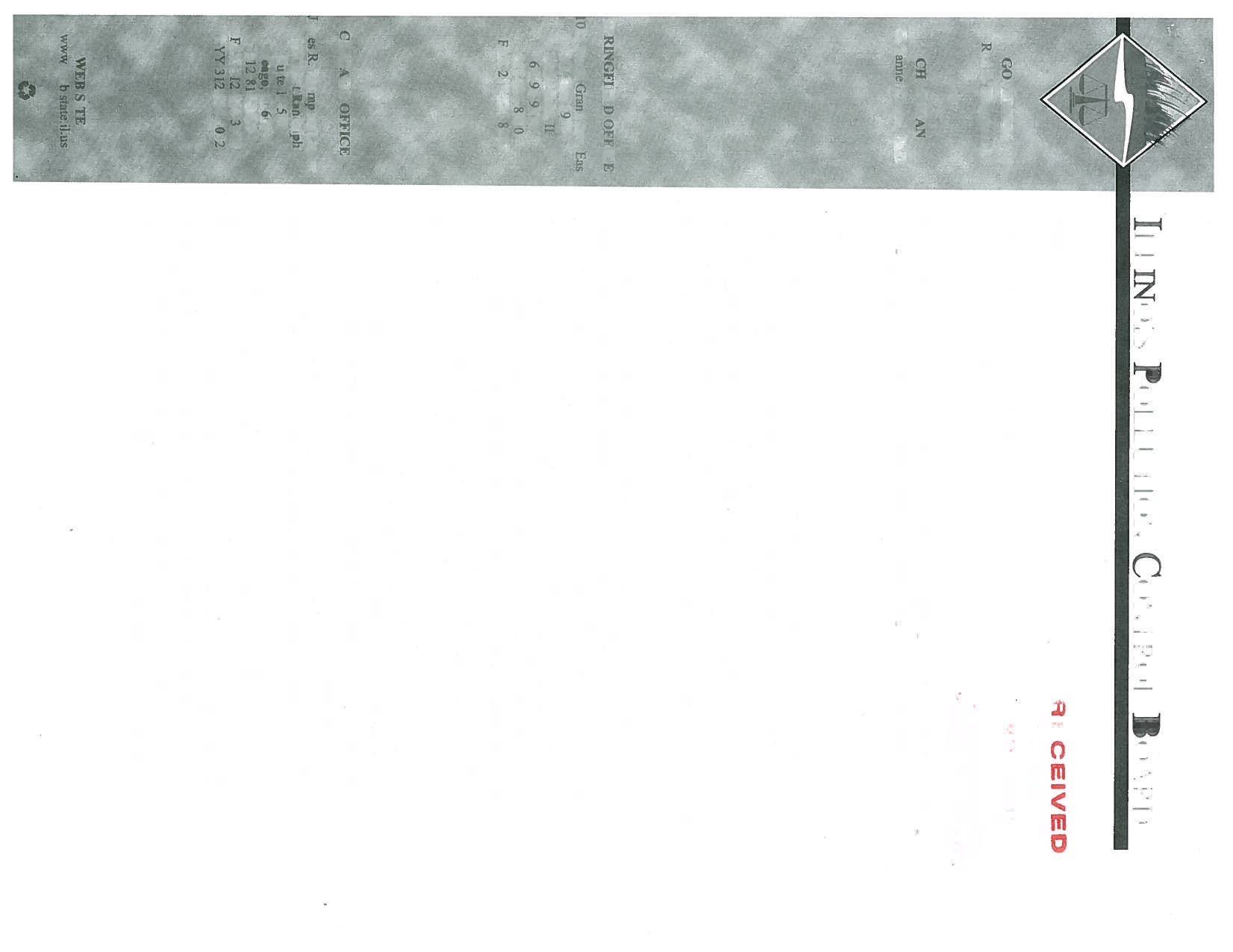May
13, 2009
Jack
Lavin,
Director
Department
of
Commerce
and
Economic
Opportunity
620
East Adams
Street,
S-6
Springfield,
Illinois
62704
Re:
Request for Economic
Impact
Study
for: Nitrogen
Oxide
(NOx)
Trading
Program
Sunset
Provisions
for Electric
Generating
Units
(EGU’s): New
35
III.
Adm.
Code 217.751, R09-20
Dear Director
Lavin:
On May 7, 2009, the
Board
accepted
for hearing an April
21, 2009
regulatory
proposal filed
by the Illinois Environmental
Protection
Agency
in
Nitrogen
Oxide
(NOx)
Trading
Program
Sunset Provisions for
Electric
Generating
Units
(EGU’s):
New 35 Ill. Adm.
Code 217.75
1, R09-20. I
am
writing
to request that your Department
conduct
an economic impact
study
concerning
this
proposal.
For reasons explained
below,
if
at all
possible,
we
would
appreciate your
response
to this request
no later than
June 30, 2009.
But,
due to
a
federal
court
ruling concerning the
federal CAIR
rules in
North
Carolina v.
USEFA,
531 F.3d
896
(C.A.D.C. Cir. 2008),
USEPA must
take
additional action
concerning its rules.
To solve the problem
of
applicability of
two
sets
of
rules,
in 40 CFR 51.123 (bb)(1)(i),
USEPA
has provided that states
such
as
Illinois
with
approved CAIR
programs may revise
their applicable
SIP so
that
the
provisions
of the NO,
SIP
Call Trading Program
do not
apply
to affected
EGUs.
IEPA’s
proposal
requesting
the Board to amend
the Illinois
rules
is
the
first
step to
revision of the SIP. IEPA
correctly
states that
EGUs must
comply
with two
sets of duplicative administrative
requirements
for the
2009
ozone
season
and
beyond: the Illinois
Clean Air
Interstate
Rule (CAIR)
requirements
at
Part 225
and the Illinois NOx
Trading Program at
Part 217. To
address and
remove the
duplication, the IEPA
proposes
to
sunset the provisions
of
the
NOx
TI I TN[flTS Pni
.1
TJTJ(
‘\T
C(V
?OL_Bo1
GOVERpR
Rod
B1evih
•
CNAIRMAN ‘
GtarcL
PhD
qECEIVED
CLERK’S OFFICE
MAY
N
2009
STATE
OF
ILLINOIS
ollutr
Control
Board
SPRGELD OE11CE
t021
NOthidVC.
Et
P.Box
12Z4,j
Spnngfie14
.
627
0z74
-‘-
2I7524F
L2l7-52
In its statement of
reasons, the IEPA
correctly states
that Illinois adopted
both the NOx Trading
Program
rules at 35
Ill. Adm.
Code
Part 217
and the
Clean
Air
Interstate
Rule
(CAIR)
at 35 Ill. Adm.
Code Part 225
after
adoption of similar
rules
by
the United
States
Environmental
Protection
Agency
(USEPA). USEPA
has approved both
sets of
rules
for inclusion
in the State Implementation
Plan
(SIP)
for ozone attainment.
As do the USEPA
rules,
the
Illinois CAIR provisions
as set forth
in 35 III.
Code
Part 225.Subpart
E include
a trading program
for
control
of NOx emissions
during
the ozone
season that replaces
the provisions
in
Part
217.Subpart
W for
EGUs
beginning
with the 2009 control
period (May
1
through
September
30)
and
thereafter.
Janwsk.
Thornson
Cenr
lOG
Westndo1ph
Sui4-5OO
.
3i-ga4-362O
;‘ F814-669
(3
8l46O32
4
Wii
wwipth;state:iis.
:;
.y.
2
Trading
Program,
by
adding
a new
Part 217.75
1 to
sunset
the
rules beginning
with
the 2009
ozone
control
season.
The
Board
denied
an
JEPA
motion
for
expedited
consideration,
but
authorized
first-notice
publication
of
the proposal
without
comment
on
the
proposal’s
merits.
The
Board
stated
that it
simply
cannot
grant
expedited
consideration
to every
rulemaking,
noting
that
it
was currently
giving
expedited
treatment
to
three
other air
rulemakings.
But, the
Board
also
agreed
to
proceed
with
the proceeding
as quickly
as
possible.
Consequently,
hearings
are
scheduled
for
June 18,
2009
in Chicago
and
July 23,
2009
in
Springfield.
Since
1998,
Section
27
(b)
of the
Environmental
Protection
Act
has
required
the
Board
to:
(1) request
that the
Department
of
Commerce
and
Economic
Opportunity
(formerly
the
Department
of Commerce
and Community
Affairs)
conduct
a study
of
the
economic
impact
of
the proposed
rules.
The
Department
may
within
30 to
45 days
of such
request
produce
a study
of
the
economic
impact
of
the
proposed
rules.
At
a
minimum,
the
economic
impact
study
shall
address
a) economic,
environmental,
and
public
health benefits
that
may
be
achieved
through
compliance
with the
proposed
rules,
b)
the
effects
of
the
proposed
rules
on
employment
levels,
commercial
productivity,
the
economic
growth
of
small businesses
with
100
or
less
employees,
and the
State’s
overall
economy,
and c)
the cost
per
unit
of
pollution
reduced
and the
variability
of
company
revenues
expected
to
be
used
to implement
the
proposed
rules;
and
(2)
conduct
at least
one public
hearing
on the
economic
impact
of
those
rules.
At
least
20 days
before
the
hearing,
the
Board
shall notify
the
public
of the
hearing
and
make
the
economic
impact
study,
or
the
Department
of Commerce
and
Economic
Opportunity’s
explanation
for
not
producing
an economic
impact
study,
available
to
the public.
Such
public
hearing
may
be held
simultaneously
or
as
a part
of any
Board
hearing
considering
such
new
rules.
415
ILCS
5/27(b)
(2006).
There
is no
decision
deadline
in
this rulemaking,
but the
Board
intends
to
proceed
expeditiously.
The Board
has
scheduled
a hearing
on
this proposal
for
June
18 and
July 23,
2009,
and
due to
budget
constraints
does
not
intend
to
hold
a
third
hearing.
Under
these
circumstances,
the
Board
asks that
you
respond
to this
request
as
soon
as
you conveniently
can,
but
in any
event no
later
than June
30,
2009;
this
would
allow the
Board
to
give
the
public
the
20-day
notice
of
the
results
of
your decisionmaking
required
by Section
27(b) of
the
Act. If
I,
or
my
staff,
can
provide
you with
any
additional
information,
please
let
me
know.
3
Thank
you in advance for
your prompt response.
Sincerely,
cc: Warren
Ribley, DCEO
John T. Therriault,
Assistant
Clerk of the Board



